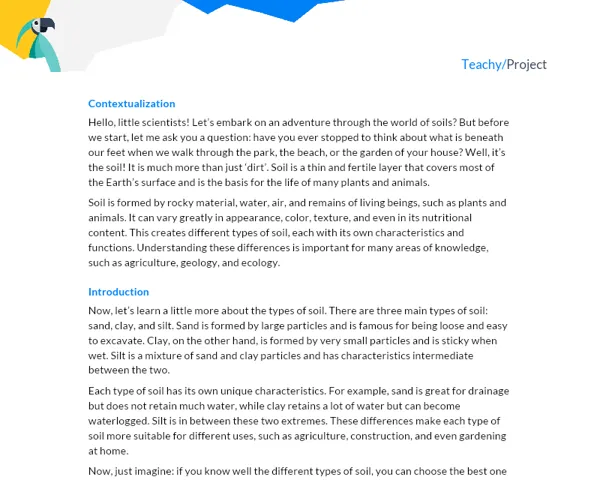Contextualization
Hello, little scientists! Let's embark on an adventure through the world of soils? But before we start, let me ask you a question: have you ever stopped to think about what is beneath our feet when we walk through the park, the beach, or the garden of your house? Well, it's the soil! It is much more than just 'dirt'. Soil is a thin and fertile layer that covers most of the Earth's surface and is the basis for the life of many plants and animals.
Soil is formed by rocky material, water, air, and remains of living beings, such as plants and animals. It can vary greatly in appearance, color, texture, and even in its nutritional content. This creates different types of soil, each with its own characteristics and functions. Understanding these differences is important for many areas of knowledge, such as agriculture, geology, and ecology.
Introduction
Now, let's learn a little more about the types of soil. There are three main types of soil: sand, clay, and silt. Sand is formed by large particles and is famous for being loose and easy to excavate. Clay, on the other hand, is formed by very small particles and is sticky when wet. Silt is a mixture of sand and clay particles and has characteristics intermediate between the two.
Each type of soil has its own unique characteristics. For example, sand is great for drainage but does not retain much water, while clay retains a lot of water but can become waterlogged. Silt is in between these two extremes. These differences make each type of soil more suitable for different uses, such as agriculture, construction, and even gardening at home.
Now, just imagine: if you know well the different types of soil, you can choose the best one for each situation. In agriculture, for example, this is essential for the good growth of plants. It is also important for building houses, roads, and other structures. And, of course, it is very useful for taking care of your home garden. So, are you ready to embark on this adventure and become an expert in soils?
Practical Activity
Activity Title: 'Exploring Soil Types'
Project Objective
This project aims to help students better understand the different types of soil and their characteristics through a practical and fun experience. Students will research, collect samples, and analyze different types of soil, and will create a visual report to share their findings with the class.
Detailed Project Description
Each group of 3 to 5 students will be responsible for researching, collecting, analyzing, and presenting information about three types of soil: sand, clay, and silt. They will use simple materials, such as transparent glass jars, water, and a stopwatch, to help identify the unique characteristics of each type of soil.
Required Materials
- Three transparent glass jars
- Water
- Samples of sand, clay, and silt (can be collected from different locations)
- A ruler
- A stopwatch or clock
- Pencil and paper for notes
- Camera or cell phone to record the process (optional)
Detailed Step-by-Step for Activity Execution
-
Research: Together, students should research the different types of soil (sand, clay, and silt). They should note the main characteristics of each.
-
Sample Collection: Students will go on a small expedition to collect samples of the three types of soil. They should choose different locations, such as a park, a beach, and the school garden, to collect the samples.
-
Soil Analysis: Back in the classroom, students will place a small sample of each type of soil in one of the glass jars. Then, they will add water to the jar until it is almost full.
-
Observation: Students will observe what happens to each type of soil when water is added. They should pay attention to the color, texture, and behavior of the soil (if it sinks or floats, if it forms bubbles, etc.).
-
Drainage Time: Students will measure how long each type of soil takes to drain the water. They can do this by observing the water level in the jar every 5 minutes and recording the results.
-
Recording: Throughout the process, students should take notes on their observations and results. They can also take photos or videos to accompany their notes.
-
Visual Report: Using their notes, photos, or videos, students will create a visual report on the different types of soil. They can use paper, cardboard, or a drawing application on the computer to create their report. The report should include the name of each type of soil, its main characteristics, their observations, and results.
-
Presentation: Each group will present their visual report to the class. They should explain what they learned about the different types of soil and how the experience helped them better understand these differences.
The groups will have two weeks to complete the project. During this time, they should work together, share their findings, and solve any challenges that may arise. Remember, the goal is to learn and have fun exploring the types of soil!

